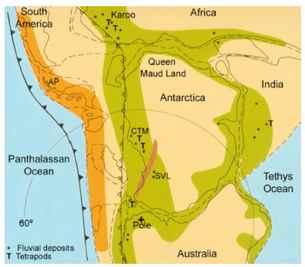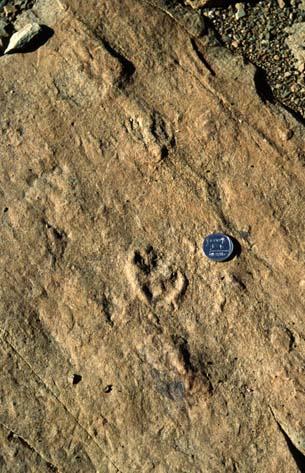Fauna and Flora
Shows principal basins on Gondwana and locations for fluvial deposits and their relations with the Tetrapodos migration.
Image Credit: After Collinson J. W. and Hammer W. R. (2007)
Imprints of Theropod, Karoo Basin South Africa
Image Credit: D. Mertmann
Tetrapods - an example of migration in Gondwana's time
The earliest known tetrapods in Antarctica occur in fluvial deposits just above the Permian-Triassic boundary in the central Transantarctic Mountains. These fossils belong to the Lystrosaurus Zone fauna that is best known from the Karoo basin in South Africa. The Antarctic fauna is less diverse because of fewer collecting opportunities and a higher paleolatitude (65º vs. 41º). Many species are in common, for example Lystrosaurus maccaigi, which is found near the base of the Triassic in Antarctica, has been identified from the Upper Permian in the Karoo. Two other species of Lystrosaurus in Antarctica are also likely to have originated in the Permian. We hypothesize that tetrapods expanded their range into higher latitudes during global warming at the Permian-Triassic boundary. The migration route of tetrapods into Antarctica was most likely along the foreland basin that stretched from South Africa to the central Transantarctic Mountains along the Panthalassan margin of Gondwana.
In Late Permian, long after Early Permian Gondwanan glaciation, tetrapod faunas occupied the Karoo basin in South Africa (Rubidge, 2005). Greenhouse warming in the Late Permian resulted in extensive Glossopteris forests in Antarctica (Taylor et al., 2000). It is possible that tetrapods may have migrated into Antarctica at the same time that they occupied southern Africa, but no identifiable Permian tetrapods have been found. Larsson (1995) reported bone fragments in sandstone of possible Permian age in Queen Maud Land. This part of Antarctic would have been close to southern Africa in Gondwana reconstructions (Fig. on the upper right). If tetrapods found their way into Antarctica in the Late Permian, widespread coal measure swamp environments would not have been conducive to bone preservation. In the Lower Triassic of Antarctica fossils are abundant in some stratigraphic sections, but absent in others, although the facies appear to be the same. It is possible that Permian tetrapods will eventually be found in Antarctica, but until then the most likely hypothesis is that sudden warming near the Permian-Triassic boundary resulted in the expansion of tetrapod habitats poleward (Collinson et al., 2006).



